Calendly Alternatives
Find your Calendly replacement. We compare 10 alternatives on features, price, and performance to help you decide on the best tool.
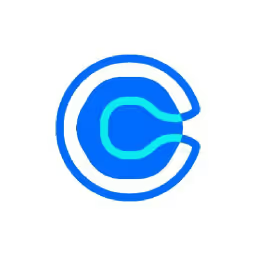
Calendly is a popular tool for good reason. It excels at simple appointment scheduling and helps eliminate back-and-forth emails. For basic one-on-one meetings, it works very well and is a solid choice for many individuals and teams.
However, some users note limitations, like a lack of deep customization or advanced features on the free plan. We analyzed the top alternatives based on G2 reviews, comparing them to Calendly to help you choose the right tool. Let's get started.
A Note On 11x For Sales Teams
For those exploring digital workers in their sales process, 11x is a relevant consideration. It offers automation for sales development tasks. This approach can support teams aiming to scale their outreach and qualification efforts.
11x is a GTM platform that uses AI agents for the sales process. Alice finds prospects, handles outreach, and updates the CRM. Julian qualifies inbound leads and books meetings. The platform unifies tools for data enrichment, outreach, and email warmup into a single system.
Calendly Alternatives
The following section provides a detailed breakdown of the top Calendly alternatives. We will analyze each tool's pricing, main features, and its advantages and drawbacks in comparison to Calendly.
1) Doodle
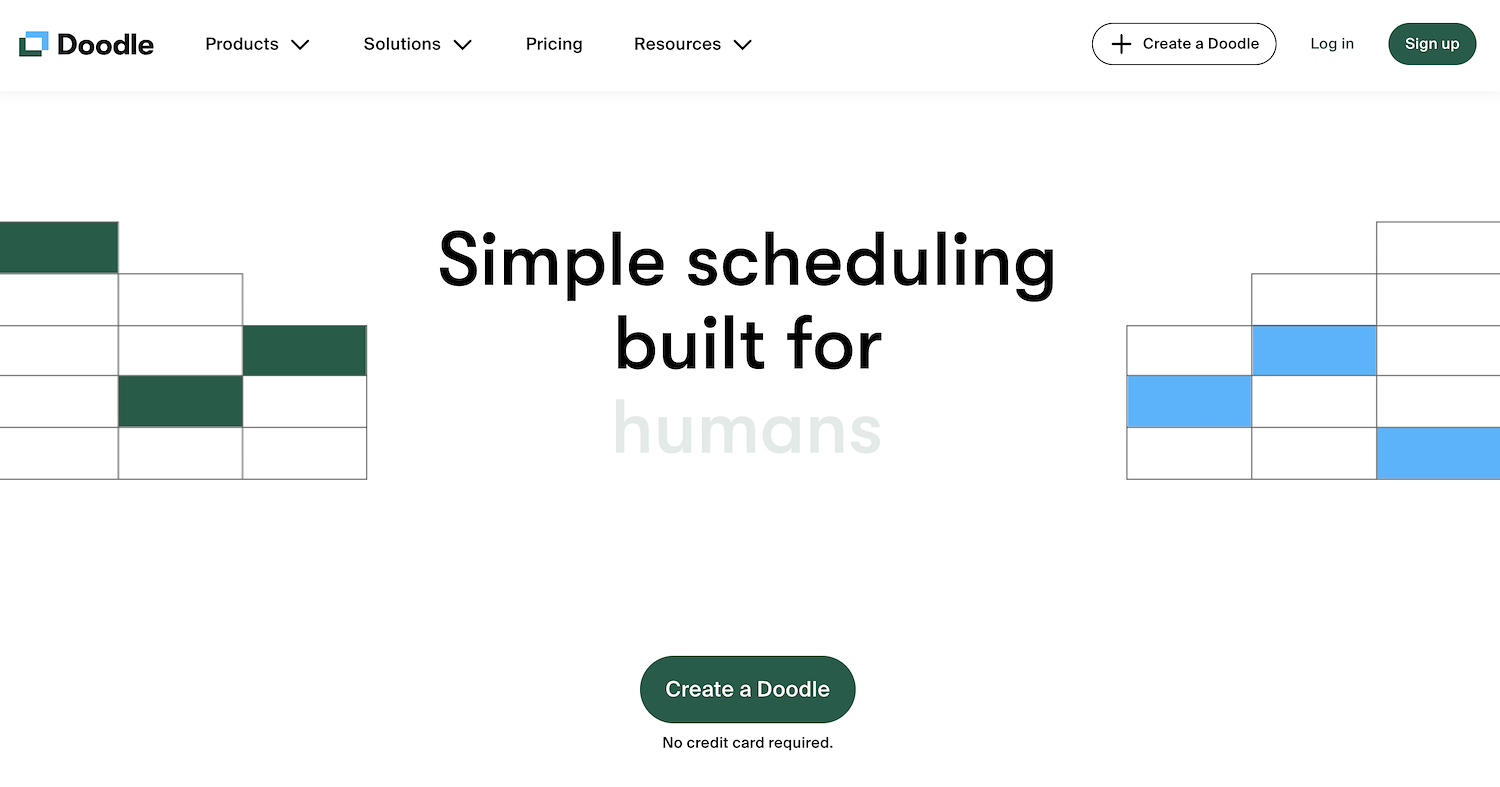
Doodle is an online scheduling platform for fast meeting arrangement. It allows users to create invitations or booking pages so participants can choose a time. The tool supports group polls for multiple invitees, one-on-one scheduling, and sign-up sheets for events like workshops.
It serves individuals, teams, and large enterprises for use cases such as recruitment, sales calls, and board meetings. The service highlights its scale, with over 70,000 companies as users.
Doodle's Main Features
The Group Poll feature finds the best meeting time by surveying multiple invitees on their availability.
Sign-Up Sheets let people claim specific time slots for events such as workshops, webinars, or training sessions.
The platform integrates with Stripe, which allows for payment collection from participants at the time of booking.
Administrative controls permit users to share a specific invitation instead of their entire calendar for greater privacy.
How Doodle Compares To Calendly
Average Review score: 4.4/5 stars based on 2,064 G2 reviews.
Doodle's Group Poll feature lets multiple people vote on the best meeting time. This approach differs from Calendly, where scheduling is typically based on one person's pre-set availability.
The platform includes Sign-up Sheets, which are useful for workshops or volunteer events where people claim slots. Calendly's system is structured more for booking appointments than managing event sign-ups.
It integrates with Stripe to collect payments directly when someone books a paid event. This is particularly useful when combined with the Sign-up Sheet feature for paid workshops.
For privacy, users can share a single event poll instead of their entire booking page. This offers more granular control over calendar visibility compared to Calendly's standard booking links.
Drawbacks Of Doodle Compared To Calendly
Doodle lacks the advanced, multi-step workflows that Calendly offers. For example, it does not automatically send custom follow-up emails or post-meeting feedback requests to attendees.
Its team features center on polling rather than automatic assignment. The platform does not have a round-robin scheduling option to distribute meetings evenly across a team as Calendly does.
Some users report occasional calendar syncing issues, which might create scheduling conflicts. This is different from Calendly, which focuses on providing a stable, real-time view of availability.
Pricing and Cost-Effectiveness
Both platforms provide a free plan for basic use. Doodle’s paid options are notably inexpensive, with its Pro plan starting at $6.95 per user per year and its Team plan at $8.95 per year, positioning it as a highly cost-effective choice.
2) Acuity Scheduling
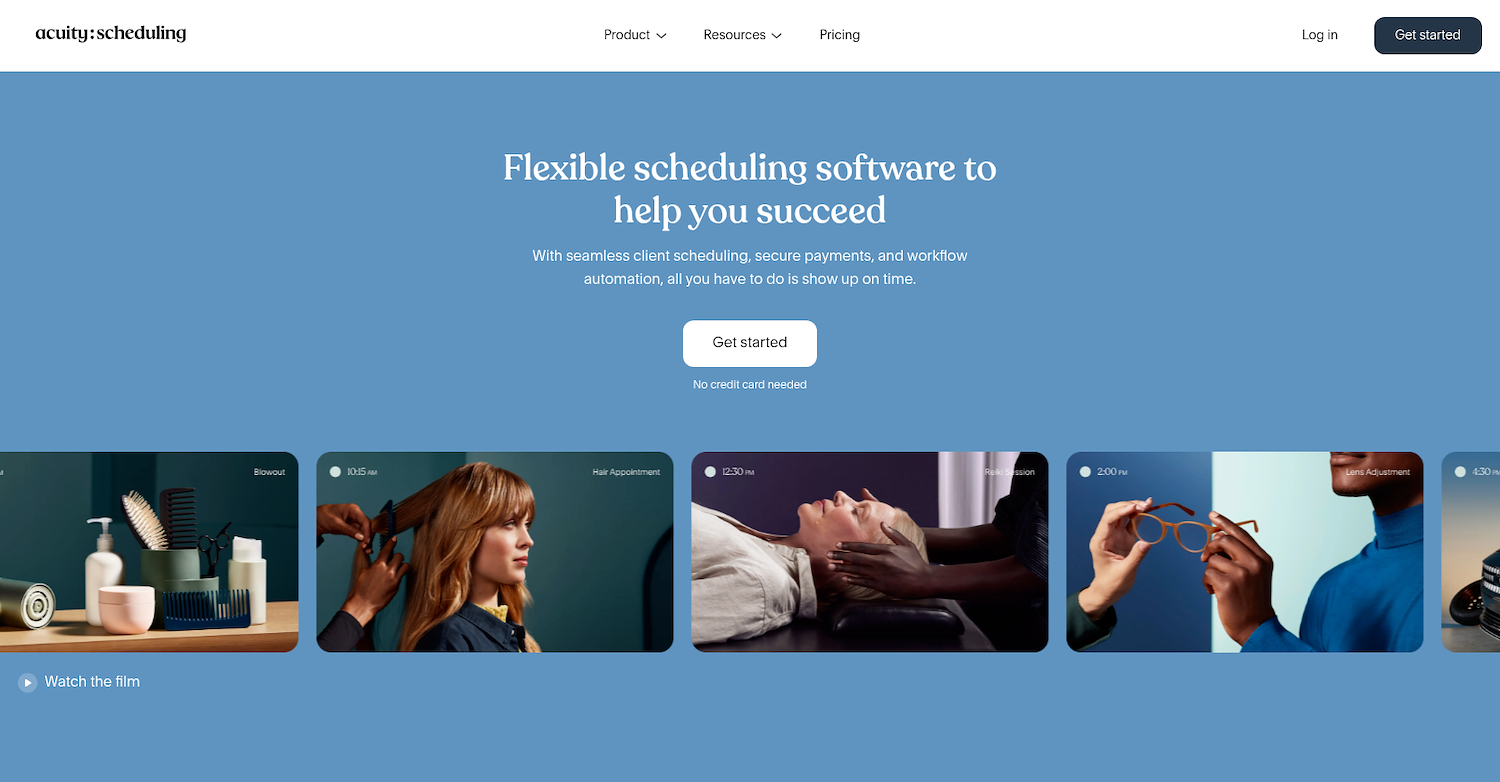
Acuity Scheduling is a Squarespace platform for service businesses. It automates appointments and client management with a branded page for clients to self-schedule, pay, and receive reminders. This reduces administrative work.
The tool manages multiple staff and locations from one dashboard. It also collects client intake information and uses deposits or card-on-file options to limit no-shows.
Acuity Scheduling's Main Features
Collects secure payments via Stripe, Square, and PayPal, with options for deposits, tipping, and card-on-file to reduce no-shows.
Gathers client information through custom intake forms and builds loyalty with coupons, gift cards, and service packages.
Offers built-in HIPAA compliance on its Premium plan for businesses handling sensitive health information.
Provides branded scheduling pages with a customizable look and feel to match a company's visual identity.
How Acuity Scheduling Compares To Calendly
Average Review score: 4.7/5 stars based on 404 G2 reviews.
Acuity Scheduling offers more flexible payment options, including deposits and tipping through Stripe, Square, and PayPal. This is different from Calendly, which primarily handles full payments at the time of booking.
The tool lets businesses sell service packages, subscriptions, and gift certificates directly. Calendly's features focus more on scheduling individual appointments rather than managing ongoing client services.
It provides more detailed client intake forms. This allows businesses to collect specific information needed for service delivery, a step beyond the basic pre-meeting questions available in Calendly.
For healthcare providers, Acuity Scheduling includes built-in HIPAA compliance on certain plans. This provides a level of security for patient data that requires a specific enterprise setup with Calendly.
The platform gives users more control over the branding of their scheduling page. This helps create a look that matches a company's website, offering more customization than Calendly's standard layout.
Drawbacks Of Acuity Compared To Calendly
Acuity Scheduling offers fewer native workflow automations. It does not automatically send complex follow-up sequences or feedback requests, a feature that is built into Calendly's higher-tier plans for post-meeting engagement.
The platform lacks a built-in round-robin scheduling feature. Unlike Calendly, it cannot automatically distribute new meetings across a team, which requires manual assignment for sales or support groups.
It does not provide a permanent free plan as Calendly does. Users get a trial period, but continued use requires a paid subscription, making it less suitable for individuals with very basic scheduling needs.
Some users report occasional calendar syncing problems. This can sometimes result in double bookings, a contrast to Calendly's focus on providing a consistently stable, real-time view of availability.
Pricing and Cost-Effectiveness
Acuity Scheduling's paid plans start at $16 per month, while Calendly offers a permanent free plan for basic use. This makes Calendly more accessible for individuals or those with minimal needs, whereas Acuity's pricing is structured for service businesses from the outset. For a full breakdown, visit Acuity Scheduling's official website.
3) ScheduleOnce
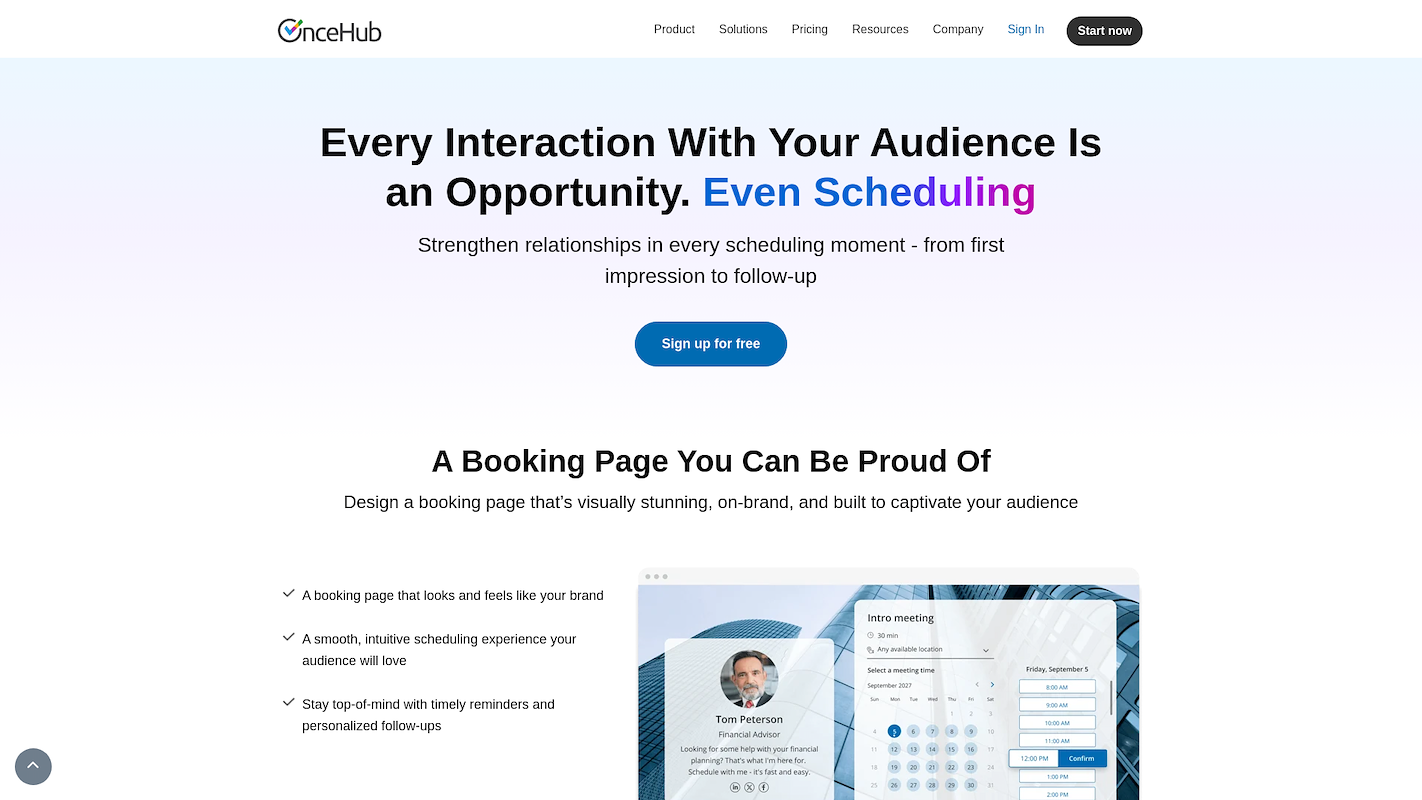
ScheduleOnce is a scheduling solution on the OnceHub platform. It uses branded pages and AI-driven conversational flows for appointments. The tool supports sales, service, and recruitment teams by providing a direct schedule process from first contact to follow-up, turning interactions into relationship opportunities.
ScheduleOnce's Main Features
Engages visitors in smart dialogues that assess urgency and purpose to route or book meetings appropriately.
Supports multi-location and hybrid teams by showing flexible availability across physical or virtual offices.
Offers enterprise-grade security with compliance for GDPR, PCI, HIPAA, and SOC 2.
Coordinates the reservation of meeting rooms and other required resources in addition to scheduling people.
How ScheduleOnce Compares To Calendly
Average Review score: 4.3/5 stars based on 52 G2 reviews.
ScheduleOnce uses chatbots to qualify leads before they book a meeting. This interactive approach differs from Calendly's more direct, form-based scheduling.
The tool coordinates the reservation of physical resources like meeting rooms. In comparison, Calendly's features focus on scheduling people's availability.
It offers advanced routing that screens and directs leads based on specific criteria. This provides more complex logic than Calendly’s standard round-robin distribution.
Its free plan supports up to three users, which benefits small teams. Calendly’s free plan, on the other hand, is limited to a single user.
Drawbacks Of ScheduleOnce Compared To Calendly
Some users find ScheduleOnce more complex to set up than Calendly. Its range of features, like advanced routing, can create a steeper learning curve for teams that need a simple scheduling tool.
The platform provides fewer visual customization options for its booking pages than Calendly. This can be a limitation for companies that want to create a scheduling experience that perfectly matches their brand identity.
It does not include native multi-step workflows like Calendly. For example, the system lacks built-in features to automatically send post-meeting feedback requests or customized follow-up sequences to attendees.
Pricing and Cost-Effectiveness
ScheduleOnce offers a free plan for up to three users, while Calendly's free tier is limited to one, making ScheduleOnce a better starting point for small teams. Paid plans for ScheduleOnce begin at $10 per user per month. For the most current pricing, visit ScheduleOnce's official website.
4) Microsoft Bookings

Microsoft Bookings is an application included with Microsoft 365 plans. It provides businesses with a web-based booking page for customers to schedule appointments. The system integrates with Outlook calendars to show current staff availability.
It is built for use cases like healthcare consultations, client meetings, or professional services. The platform automates appointment confirmations and reminders to reduce no-shows and allows for central management of team schedules.
Microsoft Bookings's Main Features
Integrates directly into Microsoft Teams, allowing users to create calendars, schedule appointments, and join meetings without leaving the application.
Creates multiple, independent calendars for different departments or locations, each with its own unique staff, services, and policies.
Defines specific appointment types with set durations, buffer times, prices, and custom fields for intake questions or cancellation policies.
Provides industry-ready templates for sectors such as financial services, healthcare, and education to speed up the setup process.
How Microsoft Bookings Compares To Calendly
Average Review score: 3.7/5 stars based on 32 G2 reviews.
Microsoft Bookings integrates directly into the Microsoft 365 suite. This offers a native scheduling experience within Teams and Outlook, unlike Calendly, which operates as a separate, third-party application.
The tool comes at no extra cost with most Microsoft 365 Business subscriptions. For companies already in the Microsoft ecosystem, this is a more budget-friendly choice than Calendly, which requires a paid plan for team features.
It supports the creation of multiple, independent booking pages for different departments or services. This allows for more granular organization compared to Calendly's structure, which is centered on individual or team-wide availability.
The platform includes industry-specific templates for fields like finance and healthcare. This helps businesses set up their booking pages quickly, offering a level of specialization that Calendly does not provide out of the box.
Drawbacks Of Microsoft Bookings Compared To Calendly
Microsoft Bookings offers fewer third-party integrations compared to Calendly. This can limit connections to specialized CRM or marketing tools, sometimes requiring manual data transfer for sales and marketing teams.
The platform provides limited visual customization for its booking pages. Calendly, in contrast, gives users more control over branding elements like colors and logos, creating a more seamless client experience.
It lacks the advanced workflow automation found in Calendly. For example, it does not natively support multi-step sequences for sending customized follow-up emails or post-meeting feedback requests to attendees.
Pricing and Cost-Effectiveness
Microsoft Bookings is included with most Microsoft 365 Business plans, making it a cost-effective choice for companies already using the suite. Calendly, in contrast, operates on a freemium model with paid plans for team features, representing a separate, dedicated expense.
5) Chili Piper

Chili Piper is a platform for revenue teams to convert inbound leads. It qualifies and routes prospects from web forms to the correct representative for an instant meeting. The system allows companies to book meetings with qualified leads directly from their website.
This tool supports sales and customer success teams. It helps them connect with prospects immediately after a form submission, which reduces lead response time.
Chili Piper's Main Features
The Form Concierge feature qualifies prospects from web forms and routes them to the correct representative for immediate booking.
Its Distro tool automates Salesforce record distribution based on complex rules, ownership assignments, and service-level agreements.
The Handoff feature automates the assignment and scheduling process between teams, such as from a sales development representative to an account executive.
It combines automated playbooks with live chat to route visitors or schedule meetings directly within the chat interface.
How Chili Piper Compares To Calendly
Average Review score: 4.6/5 stars based on 688 G2 reviews.
Chili Piper qualifies and routes leads directly from web forms for immediate booking. This differs from Calendly, where form submissions typically require a separate step before a meeting is scheduled with the right person.
The platform provides advanced lead routing based on complex rules, such as territory or account ownership. This allows for more specific assignments than Calendly's standard round-robin distribution.
Its Handoff feature automates the scheduling process between different team members, for example, from a sales development rep to an account executive. Calendly's system is less focused on this specific multi-step internal transfer.
The tool allows prospects to book meetings directly within a live chat conversation on a website. In contrast, Calendly scheduling usually happens after the chat, when a user clicks a separate booking link.
Drawbacks Of Chili Piper Compared To Calendly
Chili Piper does not offer a permanent free plan. This makes it less accessible for individuals or teams with basic needs, unlike Calendly, which provides a free tier for single users.
Some users report the tool has a steeper learning curve. Its focus on complex sales routing can require more technical setup compared to Calendly's more straightforward interface.
The platform is highly specialized for sales and revenue teams. This focus means it may lack the flexibility for other use cases, like internal meetings, where Calendly's general-purpose design is suitable.
It provides fewer options for automated post-meeting workflows. Calendly allows users to build multi-step sequences for sending feedback surveys, a feature not native to Chili Piper's core function.
Pricing and Cost-Effectiveness
Chili Piper's paid plans start at $15 per user per month for its scheduling tools. In contrast, Calendly offers a permanent free plan for individuals. This difference makes Calendly more accessible for basic use, while Chili Piper is priced for revenue teams from the outset.
Automate Your Sales Process With 11x
If your goal is to automate sales development, consider 11x. The platform uses digital workers for prospect research, outreach, and lead qualification. This method supports teams that need to scale sales operations beyond simple appointment tools. See if 11x fits your sales strategy.
With 11x, we use AI to manage the entire sales process. Alice identifies accounts, enriches data, and handles outreach. Julian takes calls, qualifies leads, and books meetings. The platform combines data, outreach, and email warmup, replacing multiple tools in a standard GTM stack.
Book a demo to see 11x in action.
6) SimplyBook.me
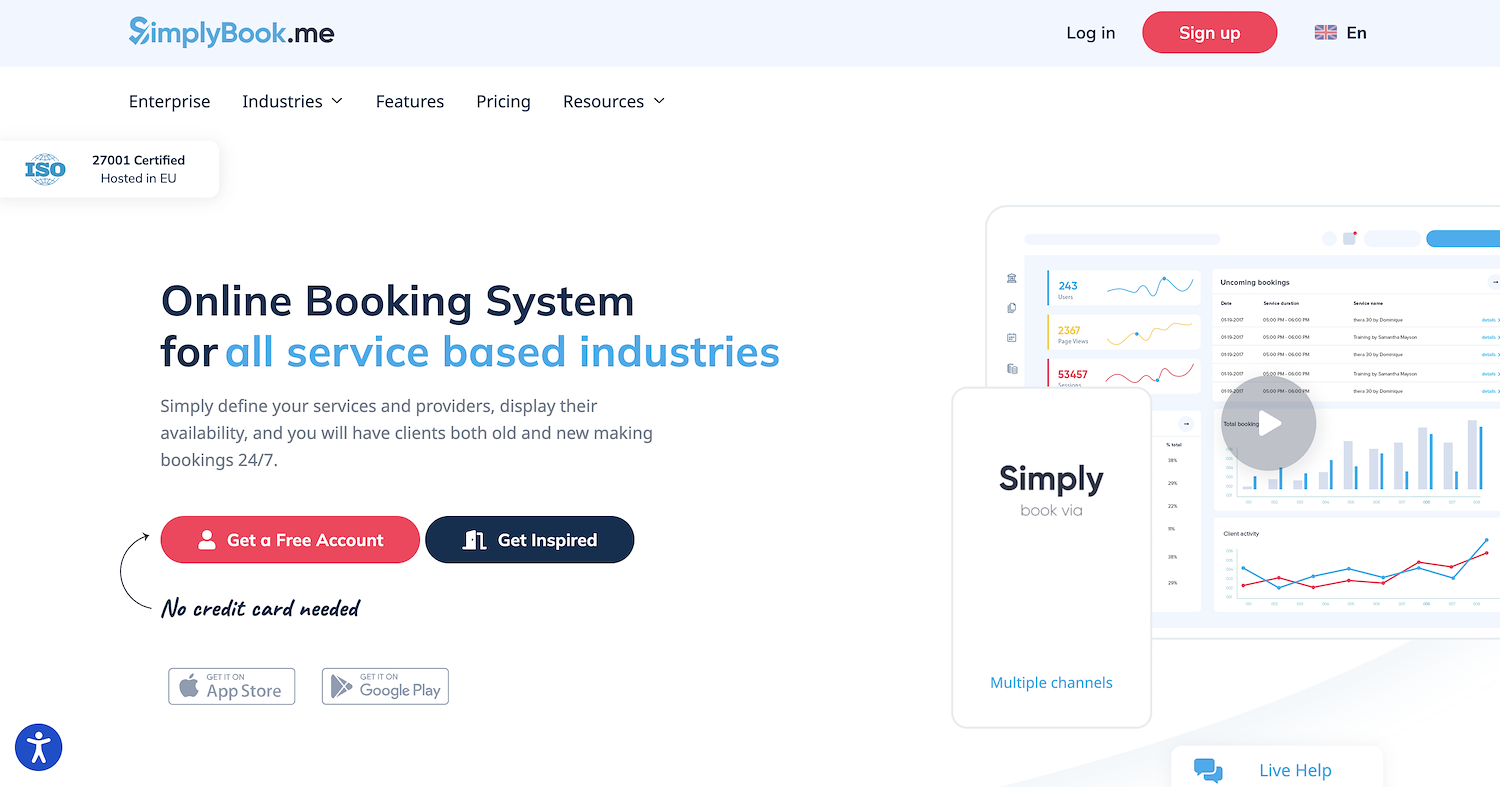
SimplyBook.me is an online booking system for service businesses. It provides a booking website or a widget for an existing site, which allows clients to book services at any time. The system sends reminders to clients and staff to reduce no-shows. It is used across sectors like health services, education, and professional services to manage appointments and classes. The platform is flexible and can be customized for different business requirements.
SimplyBook.me's Main Features
The platform provides omnichannel booking options, allowing clients to schedule through a dedicated website, social media, Google, or a branded client app.
It offers over 50 custom features, such as the ability to sell products, manage memberships, run a loyalty system, and use HIPAA-compliant intake forms.
The system accepts both online and in-store payments via Stripe, PayPal, and POS options like Tap & Pay or QR codes.
A built-in marketing suite lets users schedule social media posts and manage ad campaigns directly on platforms like Google, Meta, and TikTok.
How SimplyBook.me Compares To Calendly
Average Review score: 4.4/5 stars based on 105 G2 reviews.
SimplyBook.me provides a branded client app for bookings. This offers a dedicated mobile channel for clients, which is different from Calendly's web-based booking pages.
The tool allows businesses to sell products and memberships directly through the booking page. Calendly's system focuses on scheduling appointments rather than managing these types of sales.
It includes a built-in marketing suite to manage ad campaigns on social media. This is a feature not found in Calendly, which requires third-party integrations for marketing automation.
This platform supports in-person payments with Point of Sale (POS) options like Tap & Pay. This extends its use to physical locations, whereas Calendly's payment features are designed for online transactions.
Drawbacks Of SimplyBook.me Compared To Calendly
SimplyBook.me does not offer native multi-step workflows. This is different from Calendly, where users can build automated sequences for post-meeting tasks, such as a feedback survey or follow-up materials.
The platform lacks an automatic round-robin distribution feature. Calendly can assign meetings to team members based on availability, which helps sales and support teams manage inbound requests without manual intervention.
Some users find the initial setup can be complex due to the large number of custom features. In comparison, Calendly's interface is often considered more direct for users who need to create a simple booking page quickly.
Pricing and Cost-Effectiveness
Both platforms offer a free plan, but SimplyBook.me provides a lower-cost entry to paid features, starting at $9.90 per month, while Calendly requires an upgrade for team functionality. For the most current pricing, visit SimplyBook.me's official website.
7) Zoho Bookings

Zoho Bookings is an online appointment application inside the Zoho software suite. It lets businesses create custom pages for clients to book appointments. The tool connects with staff calendars to show real-time availability and prevent double bookings.
It is built for service-based businesses, consultants, and sales teams to manage client meetings. The platform integrates with other Zoho applications like CRM and Calendar.
Zoho Bookings's Main Features
Provides workspaces with separate dashboards for different departments or locations, including role-based permissions.
Integrates natively with Zoho CRM and connects to other CRMs through Zapier and Zoho Flow.
Uses an AI-powered setup to automatically customize labels for staff and resources during the onboarding process.
Collects payments or deposits through integrations with Stripe, PayPal, and Razorpay.
How Zoho Bookings Compares To Calendly
Average Review score: 3.8/5 stars based on 18 G2 reviews.
Zoho Bookings integrates natively with other Zoho apps, like its CRM. This offers a more connected system for businesses in the Zoho ecosystem than Calendly, which connects through third-party tools.
The platform provides separate workspaces for different departments. This allows for more detailed organization compared to Calendly's focus on individual or team-level pages.
It uses an AI-powered setup to suggest custom labels for staff and services. This differs from Calendly's manual configuration process.
For businesses that use the Zoho One suite, the tool comes at no extra cost. This makes it a more budget-friendly option than paying for a separate Calendly subscription.
Drawbacks Of Zoho Bookings Compared To Calendly
Zoho Bookings offers less advanced workflow automation compared to Calendly. For example, it does not have built-in, multi-step sequences to automatically send post-meeting feedback surveys or customized follow-up materials to attendees.
It lacks a native round-robin scheduling feature. Unlike Calendly, the tool cannot automatically assign new meetings across a team, which sometimes requires manual work for sales or support groups to distribute leads.
The platform provides fewer visual customization options for its booking pages than Calendly. Some users find this can be a limitation for businesses that want to create a scheduling experience that perfectly matches their brand identity.
Pricing and Cost-Effectiveness
Both tools offer a free plan for one user, but Zoho Bookings' paid plans start at $6 per user per month, providing a lower-cost entry point for teams. The tool is also included at no extra cost for users of the Zoho One suite, making it a more budget-friendly option for businesses already in that ecosystem.
8) YouCanBook.me

YouCanBook.me is an online scheduling tool that connects to a user's calendar to create a public booking page. Clients view real-time availability and book appointments directly. The system is for professionals and teams in customer service, recruitment, and education. It automates the appointment process to reduce administrative work and prevent schedule conflicts from a central dashboard.
YouCanBook.me's Main Features
Offers multiple display options and customizable notifications to create a unique booking page.
Automates the creation of video links, CRM updates, follow-up messages, and no-show tracking.
Sends text notifications to clients for scheduling, cancellations, and rescheduling.
Provides an API for deeper integration with other business systems.
How YouCanBook.me Compares To Calendly
Average Review score: 4.7/5 stars based on 1,923 G2 reviews.
YouCanBook.me provides more display options for its booking pages, which allows for a more unique look compared to Calendly's more standardized layouts.
The tool sends automated text notifications for bookings, cancellations, and rescheduling. This is a core part of its communication system, while Calendly offers similar features on its paid plans.
It automates follow-up messages and tracks no-shows directly within its system. This differs from Calendly, which typically uses multi-step workflows on higher-tier plans for these tasks.
The platform offers an API for deeper, custom integrations with other business software. This gives technical teams more control than the standard integrations available in Calendly.
Drawbacks Of YouCanBook.me Compared To Calendly
YouCanBook.me lacks a native round-robin distribution feature for teams. This is different from Calendly, which automatically assigns meetings based on availability, a function that helps sales teams manage inbound leads without manual work.
The platform's automation is less focused on multi-step sequences. Calendly, in comparison, allows users to build more complex workflows, such as sending a feedback survey two days after a meeting, which is not a built-in option here.
Some users find the setup for specific rules can be complex. For instance, creating unique availability for different event types might require more configuration than Calendly's more streamlined interface for the same task.
Pricing and Cost-Effectiveness
Both platforms offer a free plan for basic use. YouCanBook.me's paid plans start at $7.20 per user per month, making it a cost-effective option for individuals, while its team plan is priced at $14.40 per user per month.
9) Setmore
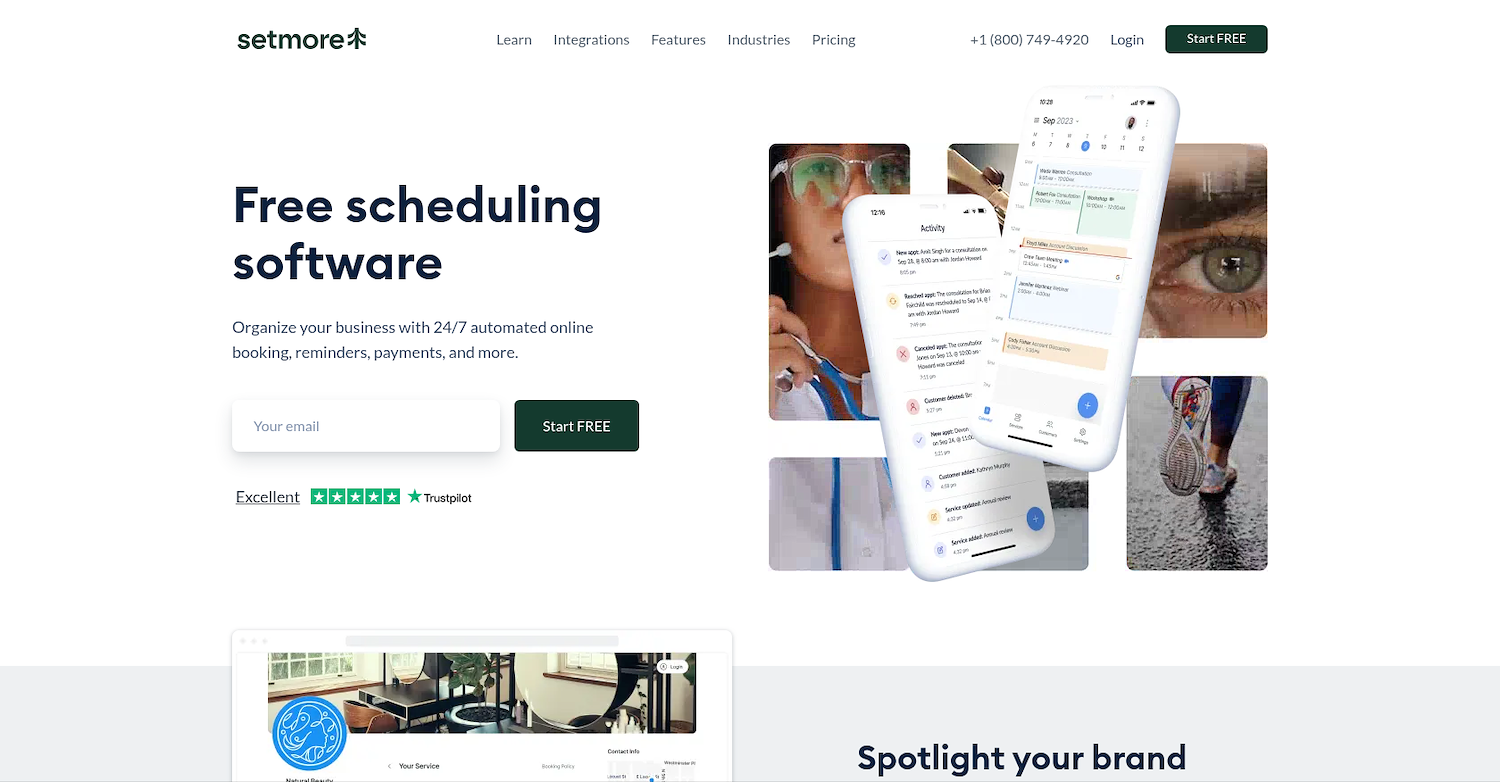
Setmore is an online appointment platform for businesses to manage schedules. It provides a booking page for clients to self-schedule appointments and classes at any time. The system is for service-based businesses in sectors like retail, beauty, and health.
It helps manage customer information from a central dashboard and sends automated reminders to clients and staff to reduce no-shows.
Setmore's Main Features
Offers a customizable booking page with scheduling options for Google, websites, and social media.
Accepts online and in-person payments through Square, Stripe, PayPal, and LawPay.
Integrates with Zoom, Google Meet, and Mailchimp, and provides an external API for custom solutions.
Includes a HIPAA-compliant version with additional data security features.
How Setmore Compares To Calendly
Average Review score: 4.5/5 stars based on 267 G2 reviews.
Setmore supports in-person payments through integrations like Square. This differs from Calendly, which focuses on online payment collection at the time of booking.
The tool provides direct booking buttons for social media platforms like Facebook and Instagram. This allows for immediate appointment scheduling from a company's profile, a feature not native to Calendly.
It offers a HIPAA-compliant version for businesses that handle sensitive health data. This provides a level of security that requires a specific enterprise setup with Calendly.
The platform includes an external API for custom integrations. This gives technical teams more control to build specific solutions compared to Calendly's standard integration options.
Drawbacks Of Setmore Compared To Calendly
Setmore lacks a native round-robin scheduling feature. Unlike Calendly, it cannot automatically distribute new meetings across a team, which may require manual assignment for sales or support groups to balance workloads.
The platform's automation is less focused on multi-step sequences. In comparison, Calendly allows users to build complex workflows, such as sending a feedback survey a few days after a meeting, a feature not built into Setmore.
Some users report that the user interface can feel complex at first. This contrasts with Calendly, which is often noted for its direct and simple setup process that allows for quicker creation of basic booking pages.
Pricing and Cost-Effectiveness
Both platforms provide a free plan. For teams, Setmore is a more budget-friendly option, with its Team plan starting at $9 per user per month, while its Pro plan offers access for two users at $12 per month.
10) TimeTrade
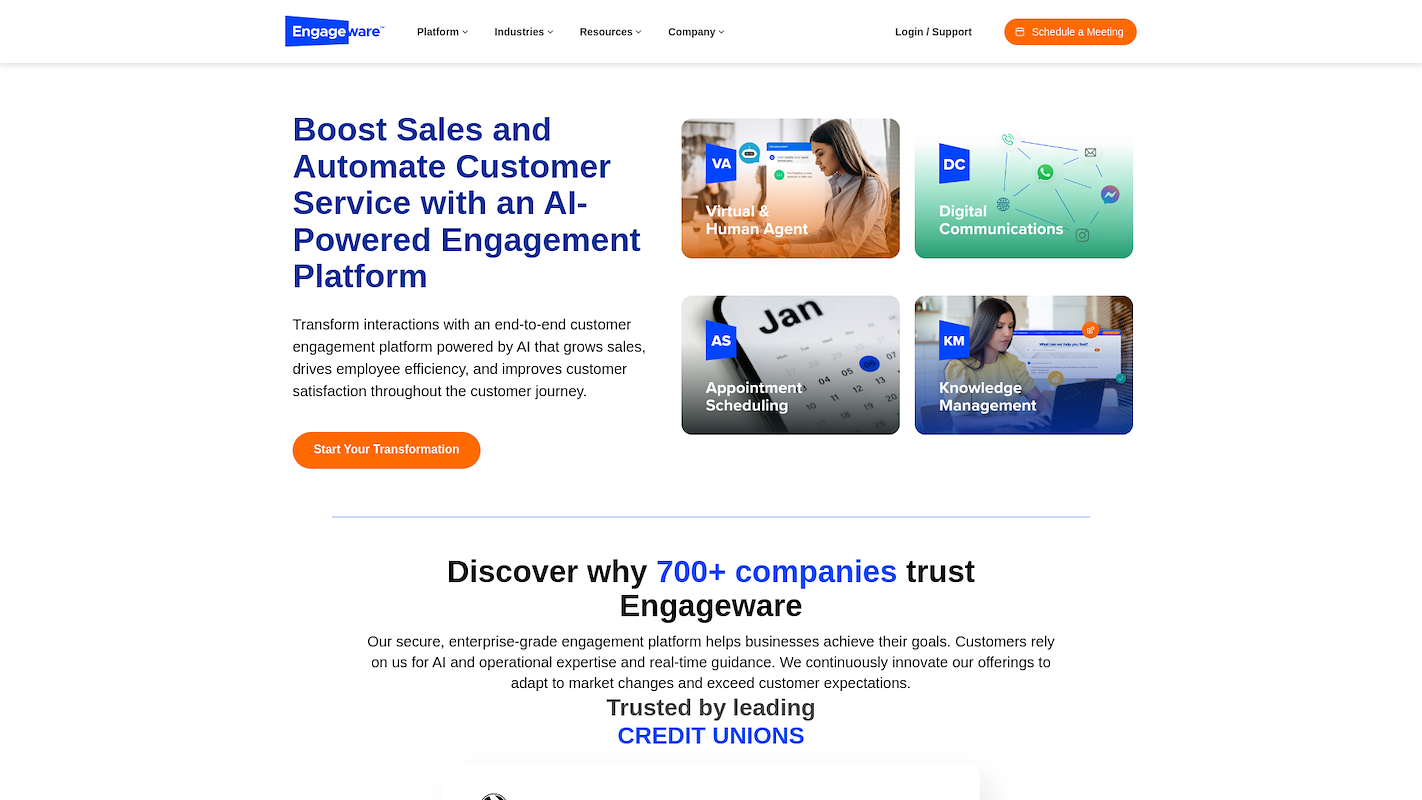
TimeTrade is an appointment platform for large organizations. It connects customers with company representatives for service. The system manages appointments across online and in-person channels. It serves industries like financial services, retail, and telecommunications.
The tool coordinates schedules for sales, service, and support teams. This process aims to improve customer interactions and operational flow.
TimeTrade's Main Features
The platform uses conversational and generative AI to power its customer engagement and knowledge management systems.
A low-code integration designer allows for the creation of custom connections to other business systems.
The system supports proactive customer engagement through campaigns on SMS and Meta social platforms.
It provides customers with 24/7 omnichannel support options.
How TimeTrade Compares To Calendly
Average Review score: 4.4/5 stars based on 127 G2 reviews.
TimeTrade uses conversational AI to interact with customers before booking. This differs from Calendly, which relies on a more direct, form-based scheduling process.
It offers a low-code designer for creating custom integrations. This provides more flexibility for technical teams than Calendly’s standard list of third-party apps.
The tool allows businesses to run proactive outreach campaigns on SMS and social media. Calendly's system is designed to react to incoming booking requests.
TimeTrade includes knowledge management features to help customers find information. This is a function not present in Calendly, which focuses purely on appointment scheduling.
Drawbacks Of TimeTrade Compared To Calendly
TimeTrade lacks the built-in, multi-step workflow automation that Calendly provides. For example, it does not have a native feature to automatically send a sequence of follow-up emails or feedback surveys to attendees after a meeting concludes.
The platform does not include a native round-robin scheduling feature. This is different from Calendly, which can automatically distribute meetings across a team. This might require manual assignment for sales or support groups to balance workloads.
Some users report that its interface can be complex. The enterprise focus may create a steeper learning curve compared to Calendly, which is often noted for its straightforward setup process for creating basic booking pages quickly.
Unlike Calendly, TimeTrade does not offer a permanent free plan. This makes it less accessible for individuals or small teams with basic scheduling needs, as continued use requires a paid subscription.
Pricing and Cost-Effectiveness
TimeTrade's individual plan is priced at $78 per year, while its business plan is $149 per year. In contrast, Calendly operates on a freemium model, offering a free plan for single users but requiring paid subscriptions for team features.
Which One Should You Go With?
Choosing a Calendly alternative depends on many variables, including your team's size, budget, and specific use case. This guide reviewed several options to help you find the right fit for your business needs.
If your focus is on automating the entire sales development process, 11x offers a different approach. Its AI agents handle tasks from prospecting to lead qualification, which can be a consideration for teams looking to scale their sales operations beyond just scheduling.




